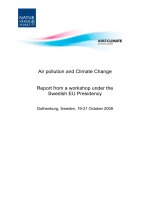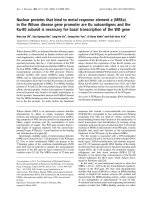First report of a trilobite in the carboniferous of Eastern Pontides, NE Turkey
Bạn đang xem bản rút gọn của tài liệu. Xem và tải ngay bản đầy đủ của tài liệu tại đây (448.01 KB, 5 trang )
Turkish Journal of Earth Sciences (Turkish J. Earth
Sci.), Vol. 20,
pp. 179–183. Copyright ©TÜBİTAK
R. KANDEMİR
& 2011,
R. LEROSEY-AUBRIL
doi:10.3906/yer-0911-3
First published online 12 October 2010
First Report of a Trilobite in the Carboniferous of
Eastern Pontides, NE Turkey
RAİF KANDEMİR1 & RUDY LEROSEY-AUBRIL2
1
Gümüşhane Üniversitesi, Jeoloji Mühendisliği Bölümü, TR−29000 Gümüşhane, Turkey
()
2
Forschungsinstitut Senckenberg, Senckenberganlage 25, D-60325 Frankfurt am Main, Germany
Received 02 November 2009; revised typescript receipt 16 September 2010; accepted 12 October 2010
Abstract: The pre-Mesozoic basement of the Eastern Pontides consists of a Permo–Carboniferous sedimentary sequence
including the Çatalçeşme and Hardişi formations. The Çatalçeşme Formation has yielded rich assemblages of fusulinids,
corals, gastropods, brachiopods, bryozoans, algae, conodonts and plants. Hitherto trilobites were unknown from this
formation; here we report the discovery of a pygidium from a dark grey limestone bed near the top. Trilobites are a
minor component of benthic marine communities during the Late Pennsylvanian, and to our knowledge, the discovery
of this pygidium constitutes the first report of their occurrence in deposits of this age in Turkey. The morphological
characteristics of the specimen, especially the number of axial rings and pleural ribs and the well-defined border (Owens
1983), suggest that it probably belongs to an undescribed species of Ditomopyge Newell, 1931 (Ditomopyginae). It also
exhibits a distortion of the posterior part of the axis, and a shortening (right side) or a fusion (left side) of some pleural
ribs, which is tentatively interpreted as repaired injuries or the results of a developmental dysfunction.
Key Words: Bayburt, Eastern Pontides, trilobite, Ditomopyginae, Carboniferous
Doğu Pontid Karbonifer’indeki İlk Trilobit Bulgusu, KD Türkiye
Özet: Doğu Pontidler’in Mesozoyik öncesi temelini oluşturan Permo−Karbonifer yaşlı çökel kayaları Çatalçeşme ve
Hardişi formasyonlarından oluşur. Çatalçeşme Formasyonu fusulinidler, mercanlar, gastropodlar, brakyopodlar,
bryozoalar, algler, konodontlar ve bitki fosillerinden oluşan oldukça zengin bir topluluğu içerir. Fakat bugüne kadar bu
formasyondaki trilobit varlığı bilinmemekteydi. Bu çalışmada Çatalçeşme Formasyonu’nun üst seviyelerine yakın koyu
gri renkli bir kireçtaşı tabakasında, sadece kuyruk kısmıyla temsil edilen, tek bir trilobit örneği bulunmuştur. Trilobitler,
Geç Pensilvaniyen süresince bentik denizel toplulukların nadir bir öğesini oluştururlar ve bu örnek Türkiye’de bu yaştaki
ilk trilobit bulgusudur. Çatalçeşme Formasyonu’ndan elde edilen örneğin morfolojik özellikleri, özellikle aksiyal halkalar
ve plevral kotların sayısı ve iyi-belirlenmiş sınırı, olasılıkla Ditomopyge Newell, 1931 cinsine ait (Ditomopyginae)
tanımlanmamış bir tür olduğu düşünülmektedir. Örnek ayrıca, eksenin arka bölümünün bükülmüş olması ve bazı
plevral kotların sağ bölümde kısalması veya sol bölümde birleşmelerini gösterir. Bu anormallikler, onarılmış yaraları
veya muhtemelen, organizmanın gelişmesi sırasındaki işlev bozukluklarının sonuçlarını temsil edebilir.
Anahtar Sözcükler: Bayburt, Doğu Pontidler, trilobit, Ditomopyginae, Karbonifer
Introduction
Near the town of Demirözü, approximately 30 km
southwest of Bayburt (Figure 1A, B), a Permo–
Carboniferous sedimentary sequence crops out,
which is of particular interest as it is the only known
representative of Palaeozoic strata in the southern
zone of the eastern Pontides. It has attracted the
attention of other researchers because of its geological
(Okay & Şahintürk 1997), stratigraphical (Ağar 1977;
Keskin et al. 1989) and palaeontological (Okay &
Leven 1996; Çapkınoğlu 2003) importance and
because of the presence of coal (Mann et al. 1998).
Okay & Leven (1996) subdivided the Demirözü
Palaeozoic sequence into the Çatalçeşme and Hardişi
formations, and documented the fusulinids occurring
in the former. Later, Çapkınoğlu (2003) investigated
the Çatalçeşme Formation and discovered the first
conodont faunas in these Permo–Carboniferous
deposits. Here, we describe the first record of a
trilobite from the Demirözü Palaeozoic.
179
A CARBONIFEROUS TRILOBITE FROM EASTERN PONTIDES
0
0
0
39 54’
39 52’
39 50’
Çatalçeşme
İstanbul
ANKARA
Bayburt
TURKEY
40
43
40
35
28
29
33
28
160 km
0
A
40 12’
51
Cebre
43
Deliklitaş Hill
alluvium (Quaternary)
45
andesite, dacite (Eocene)
Büyükcücüğe Hill
Şenköy Formation
(Early-Middle Jurassic)
Çaltepe limestone
(Jurassic)
36
0
40 11’
Hardişi Formation
(Late Carboniferous-Early Permian)
Çatalçeşme Formation
(Late Carboniferous)
N
Kel Hill
23
44
sample location
45
strike and dip
0
40 10’
Çatalçeşme Formation
Meter
Hardişi Formation
thrust
C
50
15
B
Demirözü
1 km
Deliklitaş Hill
thickly bedded to massive, pink, white red arkosic arenites and pebbly arenites
40
30
20
10
Trilobite
alternation of sandstone, pebbly sandstone, quartzite, dark limestone, siltstone,
and shale with rare thin coal seams
0
Figure 1. Location of the trilobite bed. (A) Map of the Palaeozoic outcrops of Turkey, (B) Geological map of the area northwest of
Demirözü, Bayburt (from Okay & Şahintürk 1997), (C) Location of trilobite horizon within the Çatalçeşme Formation.
Geological Setting and Stratigraphy
The regional geological setting was initially studied
by Ketin (1951). The pre-Mesozoic basement of the
eastern Pontides consists of various units with different
lithologies and tectonic features. These include highgrade metamorphic rocks, Lower Carboniferous
granitoids, Upper Carboniferous–Lower Permian
shallow marine to terrigenous deposits, and
Permo–Triassic low-grade metamorphic rocks. The
relationships between these units are poorly known
because they are mostly concealed beneath the
overlying Mesozoic–Tertiary cover, and affected by
Alpine tectonic movements.
The Permo–Carboniferous sedimentary sequence
forms the base of the Cebre autochthon (Okay
180
& Şahintürk 1997). The Çatalçeşme Formation
comprises a heterogenous series of sandstone,
pebbly sandstone, quartzite, dark limestone,
siltstone, and shale with rare thin coal seams.
Limestones, including the bed that yielded the
trilobite pygidium, are medium to thickly bedded,
and generally dark grey to black. The thickness of
individual limestone horizons ranges from several
decimetres to decametres and the overall thickness
of the Çatalçeşme Formation is 1000 metres. Okay &
Leven (1996) emphasized that there are more than
twenty limestone horizons in the sequence. The age
of the formation is Desmoinesian–Virgilian (late
Moscovian–early Gzhelian) according to fusulinids
(Okay & Leven 1996) and Desmoinesian according
R. KANDEMİR & R. LEROSEY-AUBRIL
to conodonts (Çapkınoğlu 2003). The stratigraphic
base of this formation is not exposed but probably
overlies the high-grade metamorphic rocks of the
Pulur Massif. The contact with the overlying Hardişi
Formation is conformable and gradational. The latter
consists of about 1000 metres of pink, brown and red
terrestrial conglomerates and sandstones. No fossils
have been found, but Okay & Leven (1996) suggested
that it might be of latest Carboniferous (Gzhelian)
to possibly earliest Permian age. The formation
is unconformably overlain by the Liassic Çaltepe
Formation which consists of carbonate rocks.
Trilobite Occurrence
The Çatalçeşme Formation has yielded rich
assemblages of fusulinids (Okay & Leven 1996),
conodonts (Çapkınoğlu 2003), corals, gastropods,
brachiopods, bryozoans, algae and plants. Here, we
report the first known occurrence of a trilobite from
this formation, represented by a single pygidium
from a dark grey limestone bed near the top (Figure
1B, C) (coordinates: 37575016°E, 4449664°N, 1758)
The pygidium is broadly elliptical in outline, with
an entire margin. Its axis is subtriangular, rounded
and slightly distorted to the right posteriorly, long
[about ninety percent of the length of the pygidium
(sag.)] and rather wide [about forty percent of the
maximum width of the pygidium (tr.) anteriorly].
It bears fifteen inter-ring furrows which are straight
medially and backwardly curved laterally, delimiting
fifteen axial rings and a terminal piece. The postaxial
field is very short and smooth. The pleural fields
are well-differentiated from the pygidial border by
strong breaks in slope and they are composed of ten
ribs defined by eleven pleural furrows that become
increasingly shallow posteriorly. Seven interpleural
furrows are present, the anterior two of which
reach the pygidial margin. The border is moderately
inflated and of sub-equal width everywhere. In lateral
view, the axis is rather high anteriorly [about forty
percent of the maximum height of the pygidium]
while it gently lowers posteriorly although with a
steep posterior margin. The post-axial field is steep.
In posterior view, the axis is rounded in cross-section.
The pleural fields are sub-horizontal adaxially and
gently slope downwards abaxially. The ventral side is
unknown. The sculpture comprises small tubercles
along the posterior margin of each axial ring
medially and along the interpleural furrows where
the pleural fields start to slope downwards. The
border bears discontinuous terrace ridges, each of
them running subparallel to the pygidial margin for
most of its course before heading towards the pleural
field anteriorly. The morphological characteristics
of the specimen, especially the number of axial
rings and pleural ribs and the well-defined border
(Owens 1983), indicate that it probably belongs to
an undetermined species of Ditomopyge Newell 1931
(Ditomopyginae) (Figure 2).
This specimen is of particular interest as it
exhibits abnormal features: distortion of the
posterior part of its axis, shortening (right side) or
fusion (left side) of some pleural ribs. These multiple
malformations might represent repaired injuries or
more likely, consequences of malfunctions during the
development of the organism (Babcock 2007). They
are particularly interesting as they indicate the ability
of trilobites to compensate for the consequences
of these malfunctions. Indeed, the outlines of the
axis and the whole pygidium are normal, which
demonstrates they were strongly constrained. Lastly,
the specimen apparently possesses two unreleased
thoracic segments and therefore it cannot be
excluded that, despite its large size, it represents a
juvenile stage.
Trilobites are a minor component of benthic
marine communities during the Pennsylvanian
(Lerosey-Aubril & Feist in press) and to our
knowledge, the discovery of this pygidium constitutes
the first report of a trilobite of this age in Turkey. Late
Palaeozoic trilobites have hitherto been known in
this country from the Mississippian of the Eastern
Taurides (Frech 1917; Hahn & Hahn 1973) and the
Permian of the Western Taurides (Lerosey-Aubril &
Angiolini 2009) and the Hazro region (Canuti et al.
1970). The Tournaisian faunule described by Frech
(1917) is in need of a review but a preliminary study of
the original material housed at the Forschungsinstitut
Senckenberg (Frankfurt am Main) suggests that
it is composed of Cummingella, Linguaphillipsia,
and Perliproetus?. The Wordian deposits of Antalya
Province have yielded four species of Pseudophillipsia:
P. (Carniphillipsia) kemerensis, P. (Nodiphillipsia)
aff. obtusicauda (Lerosey-Aubril & Angiolini 2009)
181
A CARBONIFEROUS TRILOBITE FROM EASTERN PONTIDES
Figure 2. (a)–(d) Ditomopyge? sp. indet., pygidium displaying abnormalities in the posterior part of the axis and the right pleural field,
Çatalçeşme Formation, Desmoinesian (late Moscovian-?early Gzhelian), vicinity of Demirozu, Eastern Pontides, SMF 86000
(a) dorsal view, (b) postero-lateral view, (c) detail of the right pleural field showing abnormally short ribs with ribs 4–6
shortening (tr.) abaxially while ribs 3 and 7 widening (tr.), (d) detail of the posterior part of the axis showing the asymmetrical
ring 13 which is twice as wide (exs.) on the left than on the right and how the alignment of following rings is shifted towards
the right (Scale bars represent 1 mm).
and two undescribed taxa (work in progress by R.
L.-A.). Lastly, Canuti et al. (1970) figured a poorly
preserved pygidium of an undetermined species
of Pseudophillipsia from the Permian of the Hazro
region. Thus, the discovery of a pygidium in the Early
Pennsylvanian of the Pontides fills a gap between
previous records of Late Palaeozoic trilobites in
Turkey.
Concluding Remarks
This discovery shows that trilobites, although they
are rare, occur in the Palaeozoic sequences of the
182
Demirözü region, NE Turkey. The genus Ditomopyge
ranges from the Early Pennsylvanian (Bashkirian;
Carboniferous) to at least the Cisuralian (Artinskian;
Permian) and is cosmopolitan throughout its
stratigraphical range (Owens & Hahn 1993). During
the Lower and Middle Pennsylvanian (Bashkirian–
Moscovian), for example, it occurred in the midcontinental US, Alaska, Western Europe (e.g., Spain),
the Urals, the Donets and Moscow Basins, and South
China. The evolutionary history of Pennsylvanian
and Permian trilobites is poorly documented
while it is in fact crucial to the understanding of
the processes that led to the extinction of these
R. KANDEMR & R. LEROSEY-AUBRIL
emblematic Palaeozoic arthropods. Indeed, as
recently demonstrated quantitatively (Lerosey-Aubril
& Feist in press), a marked drop of trilobite generic
diversity associated with a significant restructuring
of trilobite communities occurred around the
Mississippian/Pennsylvanian boundary. Trilobite
communities are then characterized by a relatively
low generic diversity and the domination of longlasting taxa, most exclusively ditomopygines. This
major structural change of trilobite communities
was apparently triggered by the onset of the icehouse climatic period, which lasted until the midEarly Permian. The evolutionary history of trilobites
therefore exemplifies particularly well how strong has
been the influence of climate changes on the diversity
and the structure of Late Palaeozoic marine benthic
faunas.
Along with few other localities, the eastern
Pontides are among the rare localities in the world
where Late Palaeozoic trilobites can be found. Any
further discoveries in the eastern Pontides will
have the potential to enhance our knowledge of the
distribution of Late Carboniferous trilobites. The
discovery reported herein therefore confirms that
fieldwork in Anatolia might produce significant
progress towards the understanding of the extinction
of trilobites.
Acknowledgements
The authors would like to thank Allart van Viersen and
an anonymous reviewer for their critical comments,
and also Erdin Bozkurt for his helpful editorial
suggestions. We also thank enol ầapknolu for his
help on the field. The trilobite specimen is housed in
the collections of the Forschungsinstitut Senckenberg
in Frankfurt am Main (SMF 86000).
References
Aar, ĩ. 1977. Geology of the Demirửzỹ (Bayburt) and Kửse (Kelkit)
Region. PhD Thesis, University of stanbul, stanbul, Turkey
[in Turkish, unpublished].
Lerosey-Aubrl, R. & Angoln, L. 2009. Permian trilobites from
Antalya Province, Turkey, and enrollment in Late Palaeozoic
trilobites. Turkish Journal of Earth Sciences 18, 427448.
Babcock, L.E. 2007. Role of malformations in elucidating trilobite
paleobiology: a historical synthesis. In: Mkulc, D.G.,
Landng, E. & Kluessendorf, J. (eds), Fabulous Fossils 300
Years of Worldwide Research on Trilobites, 319. New York State
Museum Bulletin 507. The University of the State New York,
the State Education Department, New York.
Lerosey-Aubrl, R. & Fest, R., in press Quantitative approach
of diversity and decline in late Palaeozoic trilobites. In:
Talent, J.A. (ed), Global Biodiversity, Extinction Intervals
and Biogeographic Perturbations Through Time. Springer
Publishing, MS 27 pp., 6 figures.
Canut, P., Marcucc, M. & Prn Radrzzan, C. 1970.
Microfacies e microfaune nelle formazioni paleozoiche
dellanticlinale di Hazro (Anatolia sud-orientale, Turchia).
Bollettino della Societa Geologica Italiana 89, 2140.
ầapknolu, . 2003. First records of conodonts from the Permo
Carboniferous of Demirửzỹ (Bayburt), Eastern Pontides, NE
Turkey. Turkish Journal of Earth Sciences 12, 199207.
Frech, F. 1917. Geologie Kleinasiens im Bereich der Bagdadbahn.
Ergebnisse
eigener
Reisen
und
palọontologische
Untersuchungen. Zeitschrift der deutschen geologischen
Gesellschaft 68, 1325.
Hahn, G. & Hahn, R. 1973. Zur Evolution von Linguaphillipsia
(Trilobita; Unter-Karbon). Senckenbergiana lethaea 53, 479
515.
Keskin, ., Korkmaz, S., Gedik, ., Ate, M., Gửk, L., Kỹỗỹmen,
O. & Erkal, T. 1989. Geology of the Region Around Bayburt.
Mineral Research and Exploration Institute of Turkey (MTA)
Report no: 8995 [in Turkish, unpublished].
Ketin, . 1951. Bayburt yửresinin jeolojisi [Geology of Bayburt
region]. stanbul ĩniversitesi Fen Fakỹltesi Mecmuas 16, 113
127.
Mann, U., Korkmaz, S., Boreham, C.J., Hertle, M., Radke, M. &
Wlkes, H. 1998. Regional geology, depositional environment
and maturity of organic matter of Early to Middle Jurassic
coals, coaly shales, shales and claystones from the Eastern
Pontides, NE Turkey. International Journal of Coal Geology 37,
257286.
Newell, N.D. 1931. New Schizophoriidae and a trilobite from the
Kansas Pennsylvanian. Journal of Paleontology 5, 260265.
Okay, A.I. & Leven, E.J. 1996. Stratigraphy and paleontology of
the Upper Palaeozoic sequence in the Pulur (Bayburt) region,
Eastern Pontides. Turkish Journal of Earth Sciences 5, 145155.
Okay, A.I. & ahintỹrk, ệ. 1997. Geology of the Eastern Pontides.
In: Robnson, A.G. (ed), Regional and Petroleum Geology of
the Black Sea and Surrounding Region. American Association
of Petroleum Geologists Memoir 68, 291311.
Owens, R.M. 1983. A review of Permian trilobite genera. Special
Papers in Palaeontology 30, 1541.
Owens, R.M. & Hahn, G. 1993. Biogeography of Carboniferous and
Permian trilobites. Geologica et Palaeontologica 27, 165180.
183









